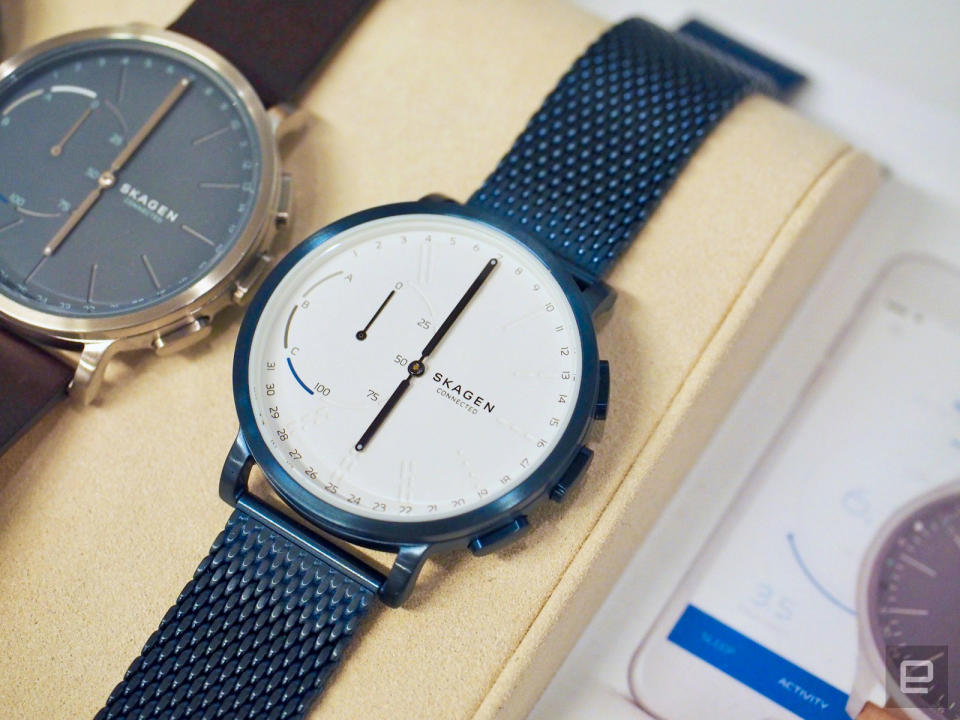Smartwatches are relying on fashion brands to survive
With an assist from Android Wear.
The 2017 lineup of Android Wear watches is a techy fashionista's dream come true. With options from an ever-growing list of designers including Louis Vuitton, Movado, Michael Kors, Emporio Armani, Tommy Hilfiger, Google's smartwatch platform is impressively diverse. Fossil Group even announced it would offer 300 new smartwatch designs by year's end, with many of those models running Android Wear. Meanwhile, big tech brands like Motorola and Microsoft have stopped making wearables altogether. The fashion industry's enthusiasm is a lifeline for smartwatches as tech companies start deserting them.
There are still a few consumer-electronics brands hanging around, like Huawei and LG. But they're outnumbered by fashion designers offering Android Wear devices in a wide range of styles and prices. That variety is by design. David Singleton, head of Android Wear, told Engadget that his team "set out to create a diverse set of devices." He believes that watches are too personal for companies to adopt a one-size-fits-all approach.
Instead, Google partnered with numerous brands from both tech and fashion to produce dozens of options for consumers. In the three years since its birth, the platform has not only acquired an impressive stable of stylish new looks and useful skills, but it has also found an identity. According to Singleton, Android Wear now revolves around the "three pillars of what smartwatches are for today -- staying healthy, staying connected and expressing your style."
That last "pillar" is particularly important and might explain why tech companies have had trouble gaining traction. "If you think about a watch — you do purchase these products as much for what they say about you and convey about yourself as well as for what they do," Singleton said. "You choose something you like the look and feel of more than anything else," he added. Early attempts from the likes of Huawei, LG and Moto were ultimately basic, cookie-cutter designs that failed to inspire longing the way a gorgeous timepiece can.
The fashion industry is a more natural fit, with its vastly superior knowledge of premium aesthetics and style. Thanks largely to partnerships with Google, brands with sartorial knowhow launched smartwatch after smartwatch after smartwatch. For the most part, these companies simply take existing designs and swap out the face for a case that runs Android Wear. It's not the most creative formula, but it has its appeal. Designers like Movado, Mont Blanc and LV bring with them ardent brand loyalists, who are willing to drop thousands of dollars on luxury timepieces. Having a connected option is a bonus these customers might consider. Movado's director of public relations, Heather Cohen Sugarman, said, "If they're going online and looking for a watch anyway and there you have a beautiful watch and being able to be connected, it's only a positive thing."
For these companies, selling smartwatches has an added benefit. "It's allowed us to tap into a younger consumer — more of a millennial-based consumer [by] attracting them to the whole techy side of things and bringing in some cool modern designs," said Sugarman.

But that's not to say tech companies aren't contributing to the development of smartwatches at all. Singleton was quick to add that Google's consumer-electronics partners "are still very important," and that some of them "push the envelope about what you can do." Fashion and tech brands target different segments of the market, he said, and "it's interesting to see the worlds come together."
Despite the combined efforts of all these big companies, wearable sales continue to slow. Apple still reigns, with the Watch Series 2 being the best-selling wearable last quarter. But Singleton isn't discouraged. "In our numbers and in our usage, what we're seeing is that everything is growing," he said, pointing to holiday seasons as periods of "exponential" growth. "Even throughout the year, we see continuous growth and we see that consumers are engaging with the product more and more over time. Every single sign is positive."

That may be the case for Google, but over at Fitbit, most signs are negative. The company just reported declines in sales and revenue for the second quarter of 2017, compared with the same period last year. Fitbit is preparing to launch its first smartwatch and is banking on that device to boost its overall performance by the end of the year. Even then, it's projecting a loss for 2017.
There may be some hope yet for wearables. According to the latest available IDC data, the worldwide wearables market grew 16.9 percent in the last quarter of 2016 over the year before. The research company expects wearables to continue doing well, thanks to the boost from fashion brands. Jitesh Ubrani, IDC's senior research analyst, wrote in a report that "much of this growth is coming from vendor push rather than consumer demand," and that "hybrid watches and other fashion accessories with fitness tracking are starting to gain traction, [presenting] an opportunity to sell multiple wearables to a single consumer under the guise of 'fashion.' "
In such uncertain times, Android Wear needs all the help it can get, and the fashion community could prove to be a crucial ally.


















